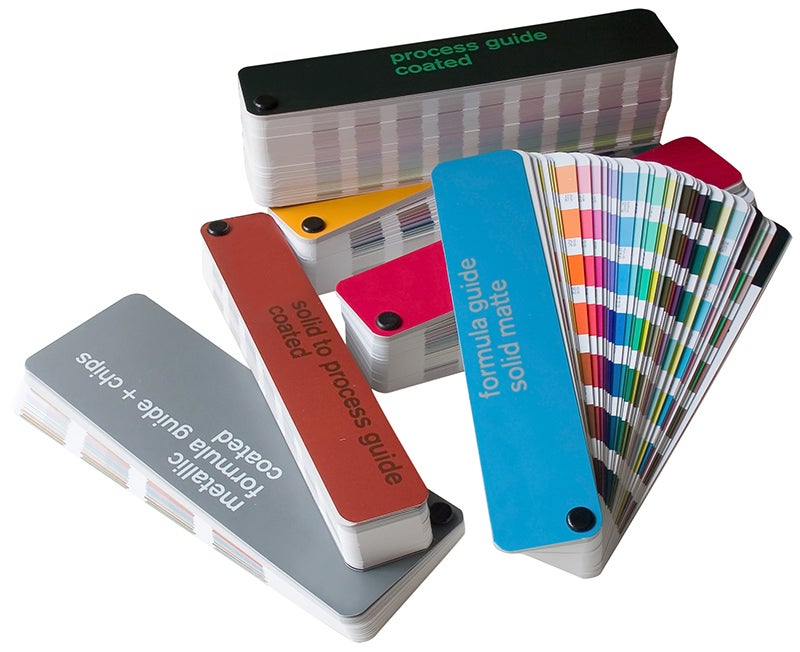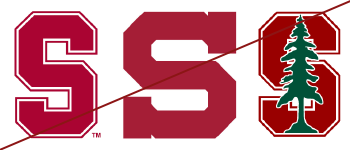Stanford Logos
The Stanford logo system includes wordmarks, block “S” with tree, university seal, the combinations of these elements, and department branding. Each logo type can be used in different ways and for different purposes. Read on for an understanding of how to use our logos.
Match logo colors
Cardinal red
Pantone 201 C
White
N/A
Black
Process black
Grey
Cool grey 11C
Palo Alto green
Pantone 3298 C
University-approved colors Cardinal red (Pantone 201C) and Palo Alto green (Pantone 3298C) must be used for logos and matched for all digital projects, print and promotional items.
For digital files, use the RGB and/or HEX values listed in our primary and accent colors pages.
For promotional items, licensed Stanford vendors must match approved Pantone colors listed above. The colors on this website are not intended to match Pantone color standards. For accurate color standards to match, refer to the current editions of Pantone color publications.

Size and clear space
Correct use of all Stanford logos includes following our minimum size and clear space requirements. These specifications ensure that our logo looks its best in most scenarios.
Make it large enough to read
Each of the Stanford logos has a different size requirement. Below are links to each.
Small merchandise such as pens and pins require particular attention to the minimum size. If the minimum size cannot be met, the logo is unreadable.

The logo may need to be larger when it is reproduced via low-resolution media such as on websites or in presentations in order to retain design integrity.
Give it enough room to breathe
There should always be a buffer zone surrounding the logo, with no type or graphics appearing in the zone. At a minimum, the space should be equal to the x-height of “Stanford” at any given size and extend above, below, to the left and to the right of the logo.
This applies to all logo, wordmark and emblem variations. Do not place other graphics or typography in the minimum clear space area, except for trademark designations when appropriate.
Clear space is particularly important when the Stanford logo is being used alongside other logos. The clear space allows all the logos to breathe and the communication to be more digestible.
Copyright

The Stanford name and all logos are proprietary and protected under intellectual property laws. One way to protect the marks is by including the proper trademark designation ® when appropriate.
Trademark designations: ™ and ® use guideline
As a general rule, use the Stanford logos with designation when they will appear on products like clothing or other merchandise (for internal or external audiences, for sale or otherwise). If you are using the block S with tree or Stanford word marks such as “Cardinal”, “The Farm”, or “Fear the Tree” on any item, you must use artwork that includes the appropriate ® or ™ trademark designation.
Please contact Trademark Licensing for information about using Stanford’s trademarks on merchandise and to obtain artwork with proper trademark designations.
When ® is not necessary:
As a general rule, ® designations are not necessary for logos that appear on most printed or digital communications (websites, email, stationery, business cards, brochures, posters, etc), or when the Stanford wordmark is used as a part of a composite mark, i.e unit signatures. Use good judgement and contact Trademark Licensing with questions.
Stanford’s name and logos are trademarks owned by the university. With limited exceptions, all products that include Stanford’s name or logos must be licensed and are royalty-bearing. Non-Stanford entities must be licensed or have approval from Stanford to use these trademarks. Stanford trademarks are not to be altered, diluted, or otherwise misused. For additional information on how to use Stanford University trademarks refer to:
Vintage & Historical logos
There have been several evolutions of the Stanford logos. We encourage use of the current Stanford logos, as past iterations i.e. “vintage marks” are no longer in use:
Do



Don’t



Stanford logo do’s and don’ts
Do
- Do use Stanford’s name and logos consistently when communicating on behalf of Stanford.
- Download the art sheet which shows correct color combinations for production of the Stanford Logo here (link to pdf).
- Do contact Trademark Licensing for approval when using Stanford’s name or logos to create merchandise or physical products (for sale or otherwise).
- Do share these design guides and resources with vendors who work on Stanford projects.
- Do use the appropriate logo for your audience:
- the wordmark and block S with tree are more versatile and appropriate for most contexts.
- the wordmark and seal communicate formality and academics.
- Do use Stanford’s name or logos for student activities only if you are a recognized student group.
- Do use Stanford’s name or logos for alumni activities only if you are a recognized alumni group.
- Do reach out to us with questions or for permission on use.
Don’t
- Don’t use Stanford’s name or logos on personal projects.
- Don’t use Stanford’s name or logos for student activities unless you are a recognized student group.
- Don’t use Stanford’s name or logos for alumni activities unless you are a recognized alumni group.
- Don’t use Stanford’s name or logos to imply a relationship, affiliation or endorsement of a product, service or business (even if you’re a vendor we’ve worked with) without approval.
- Don’t give permission to anyone outside of Stanford (including vendors, donors and research sponsors) to use Stanford’s name or logos to imply a relationship, affiliation or endorsement of a product, service or business without approval.
- Don’t place Stanford’s logos alongside or as a part of another logo.
- Don’t use Stanford’s name or logos as a part of a non-Stanford product, business or services name or logo.
- Don’t translate the Stanford name into other languages. It is a proper noun that cannot be translated.
- Don’t alter Stanford’s logos in any way.



